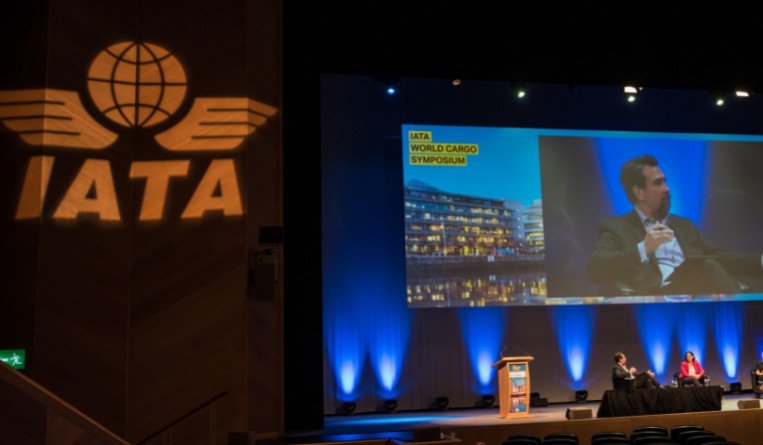Ahead of an expected bright future, the International Air Transport Association (IATA) has outlined a tripartite work programme it believes will help cargo build on the gains of the pandemic, Brendan Sullivan, the association’s head of cargo, told its World Cargo Symposium in Dublin on October 12.
Cargo demand this year is expected to exceed pre-crisis (2019) levels by 8% and revenues are expected to rise to a record US$175 billion, with yields expected to grow by 15%, Sullivan told the WCS.
Next year is shaping up to be even better, with demand expected to exceed pre-crisis (2019) levels by 13% with revenues of US$169 billion. However, there will be an 8% decline in yields as more capacity comes on line, Sullivan said.
Outlooks both short- and long-term are good. Indicators such as inventory levels and manufacturing output are favourable, world trade is forecast to grow at 9.5% this year and 5.6% in 2022, ecommerce continues to grow at double-digit rates and demand for high-value specialized cargo – such as temperature-sensitive healthcare goods and vaccines – is rising, Sullivan said.
“The surge in demand for air cargo and attractive yields are not without complications. Pandemic restrictions have led to severe global supply chain congestion and created hardships for air crew crossing international borders. Resourcing and capacity, handling and facility space and logistics will be an issue. This will create further operational challenges for our industry that must be planned for now,” he said.
For its part, IATA used the symposium to outline a three-pronged strategy to meet these challenges: safety, digitalization – or, as Sullivan put it, “continue modernizing processes” – and sustainability. Sustainability was very much a theme of the WCS as the industry comes to acknowledge the severity of the climate crisis and starts to put in place solutions.
“We are making progress,” Sullivan said of digitalization, which was more used during the pandemic in order to cut the risk of paper-borne transmission. Customs authorities in India established an automated release of import consignments via electronic data interchange throughout the country and several EU member states started accepting electronic certificates instead of the original paper certificate.
Helping further has been growth in cross-border ecommerce and items requiring special handling, such those with time- and temperature-sensitive payloads where customers want to know where their items are – and what condition they’re in.
“We need to build on this momentum,” Sullivan said, adding moments later: “We are making progress.”
He gave two examples, one effectively a landmark. The e-airway bill (e-AWB) which the industry has been hearing about for years is now at 75% adoption, but because of the pandemic has been adopted at a much faster rate than previously. “We hope to achieve 100% by the end of 2022,” he said.
Less of a change, and with substantial work still to do, is the ONE Record initiative, which envisages the whole supply chain working together with one standardized and exchangeable set of data. So far, though, there are only 17 pilot projects involving 145 companies and three customs offices underway.
Sullivan also signaled an industry-wide move to a more uniform approach with IATA’s Cargo XML messaging standards being accepted by an increasing number of customs authorities, as other IATA initiatives such as Cargo iQ, Digital Cargo and Smart Facility help create commonality in procedures to see the industry operate as efficiently as possible.
“These are big projects. And they are moving us in the right direction. So that is good. But we need to continue working at the same pace as we did during the Covid crisis,” Sullivan said.
One of the key issues for the industry is, as always, safety, with Sullivan underscoring the need to address “as a priority, the transport of lithium batteries.” Brought about by the rise in demand for them, the risk of fires has grown sharply. A particular target of IATA’s is “rogue shippers who misdeclare shipments.”
What IATA is proposing is working with regulatory authorities – he specifically mentioned the European Union Aviation Space Agency and the U.S. Federal Aviation Administration – to develop a test standard to be used to demonstrate the capabilities of fire containment covers.
This is a clear change from the past, with more dialogue with governments on how to tackle those rogue producers and exporters. “It’s a state issue,” Sullivan flatly told reporters.
There is strong industry support for this position. Guillaume Halleux, chief cargo officer for Qatar Airways in Doha, pointed out three recent incidents involving lithium batteries. “All had fraudulent declarations,” he said.
All procedures had been followed to the letter, so solving the problem requires a change in the law, he noted. “The only way to do it is to regulate,” Halleux told the WCS.
The industry will also a have a role, more distinct and precise than in the past, and will collect more incident data and develop methods for this to be shared to support the airlines’ safety risk assessment processes, Sullivan added.
On a whole other level, cargo will also be pitching in to help IATA meet its targets of net-zero carbon emissions by 2050.
This has been on the agenda for some time. However, the week prior to the WCS, IATA’s annual general meeting had underlined its commitment to a zero-emission policy. Freight, despite its position as the airlines’ golden child at moment, is not immune to IATA’s activism to help solve the climate crisis.
No work plan was outlined, but with references to re-fleeting, including the adoption of electronic aircraft, sustainable aviation fuels (SAF) and electrification of ramp vehicles, there were hints of what is likely to come – and its likely to be big.
Michael Mackey



